by Robert W. Park
Click on any photo for a larger view
Citizens Energy Cooperative
First, in March 2006, my wife and I attended a presentation by the Citizens Energy Cooperative of Wisconsin organized by DOERS, a humanitarian group in Madison. The DOERS flyer presented the case for coming up with the $200 membership fee to join CEC. We were already very interested in installing a solar thermal collector, and after learning that the $200 would be deducted from the cost of a collector purchased through CEC, we joined and put in our order. CEC sent Ben Nusz to do our site evaluation. We found that a spot on our garage roof was shade free for enough hours per day to allow an installation that could pay for itself over a period of several years. The collectors offered by CEC were being made by Wisconsin's only thermal collector manufacturer, Solar Mining Co. of Green Bay. We considered two sizes, 64 sq. ft. and 78 sq. ft. The latter seemed larger than we needed, but we decided to go with the 78 sq. ft. unit after being told that the cost to us, after the federal tax credit and a 30% rebate from Focus on Energy, would be only $50 more than the 64 sq. ft. unit. Expecting the larger unit to provide all our summer hot water needs and then some, we chose to have the collector set at a 50 degree angle (rather than 45 degrees) to increase fall through spring collection efficiency.
The Hail Storm
The death of an aunt resulted in an unplanned trip to Ontario in mid April. We traveled with my brother from Minneapolis, who left his car in our driveway. We did not notice anything amiss on our return, but when my brother got back to Minneapolis he noticed numerous dents in his car. He called to ask if Madison had had a hail storm while we were in Ontario. 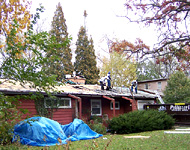 We soon learned that our part of Madison had experienced a hail storm with golf-ball sized hail. Most of the houses in our neighborhood were having their roofs inspected by insurance inspectors. We did the same, and enough damage was found to persuade our insurance company to pay for reshingling the entire roof. We were told this should be done before the collector was mounted on the roof, so the solar installation was put on hold until the roof was completed. The roofing job finally took place in October (shown above), allowing the solar installation to be scheduled for early November.
We soon learned that our part of Madison had experienced a hail storm with golf-ball sized hail. Most of the houses in our neighborhood were having their roofs inspected by insurance inspectors. We did the same, and enough damage was found to persuade our insurance company to pay for reshingling the entire roof. We were told this should be done before the collector was mounted on the roof, so the solar installation was put on hold until the roof was completed. The roofing job finally took place in October (shown above), allowing the solar installation to be scheduled for early November.
The Crane Guy
A week before the scheduled installation date, a large yellow crane showed up at our house. The driver said he was here for the solar collector installation. 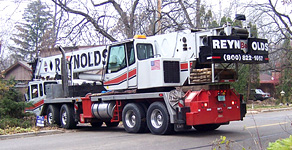 I told him that he was a week early. He confirmed that fact on his cell phone, and drove away. A week later the monstrous crane shown in the photo at right pulled into our driveway. It was many time larger than needed to lift our collector to the roof, but the driver said he had been in our part of town for another job, so why not? It was too big to operate under the power and phone lines to our house, so after some reconnoitering they gave up, took it away, and came back with the more appropriate yellow crane. The collector arrived on a flat-bed trailer, and was lifted on to the roof by the crane.
I told him that he was a week early. He confirmed that fact on his cell phone, and drove away. A week later the monstrous crane shown in the photo at right pulled into our driveway. It was many time larger than needed to lift our collector to the roof, but the driver said he had been in our part of town for another job, so why not? It was too big to operate under the power and phone lines to our house, so after some reconnoitering they gave up, took it away, and came back with the more appropriate yellow crane. The collector arrived on a flat-bed trailer, and was lifted on to the roof by the crane.
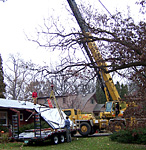 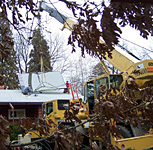 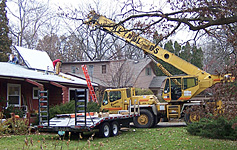 |
Soft Roof Problems
CEC's primary subcontractor for installations in the Madison area was Seventh Generation Energy Systems. They were responsible for securing the collector to the roof, placing the solar storage tank in the basement, and installing the plumbing between them. 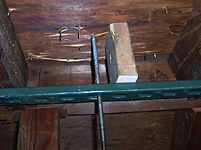 Once this was done I looked over their work and was concerned by what I saw on the underside of my garage roof beneath the two upper collector feet. Although the roofers had replaced roof plywood the previous month where they thought it was necessary, the reshingled roof was still noticeably soft in some spots. The photo at right shows how splintered and bowed in the roof plywood was below the upper left collector foot. The foot had been installed without anything to reinforce the plywood other than an unsecured piece of 2 x 4 wedged in between the plywood and the metal Unistrut "U" bar, and the bar was held in place only by the threaded rod passing through the roof to the collector foot on the shingles above. I was not confident that this footing would survive the next 30 or 40 years of wind storms tugging on the collector. To deal with the problem I cut a wooden brace to fit between the rafters, as shown below (and did the same for the other upper foot) and explained my concern to the installation crew leader. Together we made the footing improvements shown below.
Once this was done I looked over their work and was concerned by what I saw on the underside of my garage roof beneath the two upper collector feet. Although the roofers had replaced roof plywood the previous month where they thought it was necessary, the reshingled roof was still noticeably soft in some spots. The photo at right shows how splintered and bowed in the roof plywood was below the upper left collector foot. The foot had been installed without anything to reinforce the plywood other than an unsecured piece of 2 x 4 wedged in between the plywood and the metal Unistrut "U" bar, and the bar was held in place only by the threaded rod passing through the roof to the collector foot on the shingles above. I was not confident that this footing would survive the next 30 or 40 years of wind storms tugging on the collector. To deal with the problem I cut a wooden brace to fit between the rafters, as shown below (and did the same for the other upper foot) and explained my concern to the installation crew leader. Together we made the footing improvements shown below.
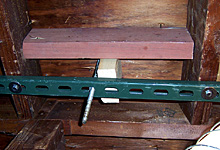 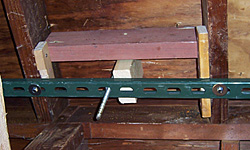 |
A Little Leak
Soon after our collector was in operation I got a call from the installation crew leader asking how things were going. I told him that the pressure reading in the glycol loop was about 60 psi. He said that was a little high, and indeed it was. We soon had a puddle of glycol on the basement floor below the pressure relief valve. The crew leader came and bled off about a quart of glycol, considerably more than the Solar Mining engineer had thought would need to be removed. After that there were no more leaks from the pressure relief valve, but sunny days rarely resulted in a peak pressure over 30 psi, and the pressure never approached the "working pressure" of 50 psi specified on the Solar Collector Design Information sheet that we had been provided by CEC.
Focus on Energy inspection
In mid December the Focus on Energy inspector arrived to check over our installation. I told him about the initial problem with the soft footing and its correction. He looked over the
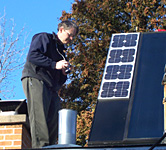 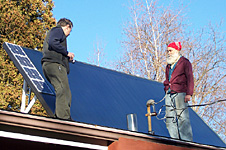 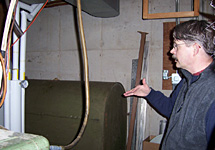 |
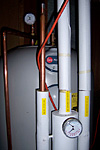 solar storage tank, heat exchanger and gages in the basement and the associated plumbing.
We had removed the heavy pipes that had been connected to the old fuel oil tank, left in a basement corner by the previous owner of the house when
solar storage tank, heat exchanger and gages in the basement and the associated plumbing.
We had removed the heavy pipes that had been connected to the old fuel oil tank, left in a basement corner by the previous owner of the house when 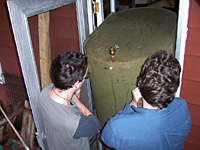 the furnace was converted to natural gas, and used the openings for the insulated pipes connecting the collector with the solar tank. A side benefit of the solar installation was that, with the heavy pipes removed, the unused fuel oil tank could now be moved. I took advantage of the presence of my 3 sons during the Christmas holidays to get the tank out of the basement. At right you can see the tank being eased out the walk-in basement doorway.
the furnace was converted to natural gas, and used the openings for the insulated pipes connecting the collector with the solar tank. A side benefit of the solar installation was that, with the heavy pipes removed, the unused fuel oil tank could now be moved. I took advantage of the presence of my 3 sons during the Christmas holidays to get the tank out of the basement. At right you can see the tank being eased out the walk-in basement doorway.
When Snow Sticks
The winter snows brought to light an interesting, if minor, problem with the Solar Mining collector design. 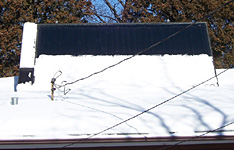 When the sun comes out after a sheet of snow has stuck to the collector, the snow covering the photovoltaic cells which run the antifreeze circulation pump melts and slides off last. The condition shown at left results in extra heat buildup in the collector because there is no circulation until the snow covering the PV panels (upper left) melts enough to slide off. The snow there melts last because there is no insulation behind the PV panels. When the PV panels eventually clear and the pump starts, the first slug of antifreeze coming from the collector is extra hot.
When the sun comes out after a sheet of snow has stuck to the collector, the snow covering the photovoltaic cells which run the antifreeze circulation pump melts and slides off last. The condition shown at left results in extra heat buildup in the collector because there is no circulation until the snow covering the PV panels (upper left) melts enough to slide off. The snow there melts last because there is no insulation behind the PV panels. When the PV panels eventually clear and the pump starts, the first slug of antifreeze coming from the collector is extra hot. 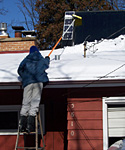 I have found this condition can produce temporary temperature spikes as high as 252°F at the basement temperature gage in our antifreeze loop. Partly because I wasn't sure such elevated temperatures were good for the collector, and partly because I was impatient to resume harvesting our incoming solar energy, I found a solution that works for me. I attached a child's plastic shovel to the end of an extendable pole from a branch trimming tool, and use it to speed up the snow removal from the PV panels (being careful not to damage those panels).
I have found this condition can produce temporary temperature spikes as high as 252°F at the basement temperature gage in our antifreeze loop. Partly because I wasn't sure such elevated temperatures were good for the collector, and partly because I was impatient to resume harvesting our incoming solar energy, I found a solution that works for me. I attached a child's plastic shovel to the end of an extendable pole from a branch trimming tool, and use it to speed up the snow removal from the PV panels (being careful not to damage those panels).
Bad News from CEC
Feb. 17, 2007 was the day of the Citizens Energy Cooperative annual membership meeting, held at Warner Park Community Recreation Center in Madison. Two new people were elected to the CEC Board of Directors. After an upbeat review of success of 2006, the CEC Executive Director dropped the bombshell. The Solar Mining Co. had closed its doors on Jan. 1. Someone named John had locked out all the employees, including the managing partner who had founded the company. Negotiations were planned to try to persuade John to turn over the large scale systems belonging to Solar Mining to CEC. Members were told that they would be emailed a newsletter explaining the situation once it was more clear where things were going. I was later told that CEC had been cut off from most of its membership database, on a computer in the Solar Mining Co. office. As of Oct. 5, 2007, the CEC membership has still not been brought up to date on the situation.
The Big Leak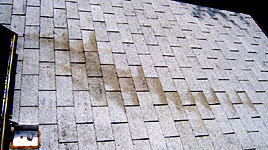 At the end of May I started seeing lower pressures than normal in our antifreeze loop which I reported to CEC. Then, on June 1, our solar system stopped working all together. On the roof I found the trails marking where antifreeze had leaked from the collector's lower frame edge in three places. The longest trail, shown at right, was below the lower right hand corner. I did not see any evidence of leaking from any of the exposed pipes, and concluded that a leak had developed inside the main part of the collector. It looked like an expensive repair requiring the collector to be opened up and perhaps removed from the roof. That should have been covered by the Solar Mining Co.
At the end of May I started seeing lower pressures than normal in our antifreeze loop which I reported to CEC. Then, on June 1, our solar system stopped working all together. On the roof I found the trails marking where antifreeze had leaked from the collector's lower frame edge in three places. The longest trail, shown at right, was below the lower right hand corner. I did not see any evidence of leaking from any of the exposed pipes, and concluded that a leak had developed inside the main part of the collector. It looked like an expensive repair requiring the collector to be opened up and perhaps removed from the roof. That should have been covered by the Solar Mining Co. 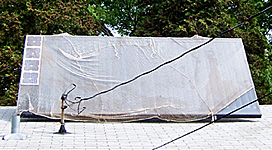 10 year warranty on the collector, but with the plant closed, it wasn't clear that warranty claims would be honored. CEC said to get the repair done and send the bill to them, but with no money to even pay their staff, it wasn't clear what they would be able to do. All this was up in the air when we started out on our summer travels. I covered the collector with some netting I had to at least give it a little protection from overheating in the summer sun with no antifreeze circulation occurring.
10 year warranty on the collector, but with the plant closed, it wasn't clear that warranty claims would be honored. CEC said to get the repair done and send the bill to them, but with no money to even pay their staff, it wasn't clear what they would be able to do. All this was up in the air when we started out on our summer travels. I covered the collector with some netting I had to at least give it a little protection from overheating in the summer sun with no antifreeze circulation occurring.
Just a Loose Nut
With trips to the west coast and upstate New York behinds us, in September I climbed on the roof again to take another look at our disfunctional collector, hoping to find a way to open up the back of the collector to get at the pipes inside the thermal section. 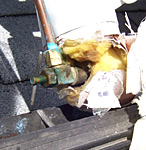 I found the insulating panels held in place by metal strips that were welded in place. Then I looked again at the narrow, open backed left side of the collector containing the PV panels, the circulation pump and the expansion tank. There, far in the lower left hand corner, I found a small needle valve I hadn't noticed before, and it was leaking! The leak seemed to be coming from the valve stem, and the valve stem nut was loose. It was easy to unscrew the metal panel covering this valve, and I took off the plastic elbow covering it up and unscrewed the valve stem nut to inspect the gasket inside. There I found a tiny rubber gasket which was at an angle when I first saw it, but it look sound. I seated it squarely and tightened the valve stem nut.
I found the insulating panels held in place by metal strips that were welded in place. Then I looked again at the narrow, open backed left side of the collector containing the PV panels, the circulation pump and the expansion tank. There, far in the lower left hand corner, I found a small needle valve I hadn't noticed before, and it was leaking! The leak seemed to be coming from the valve stem, and the valve stem nut was loose. It was easy to unscrew the metal panel covering this valve, and I took off the plastic elbow covering it up and unscrewed the valve stem nut to inspect the gasket inside. There I found a tiny rubber gasket which was at an angle when I first saw it, but it look sound. I seated it squarely and tightened the valve stem nut.  This seemed to stop the leak. I noticed that some of the antifreeze which had leaked out during this process had run down the channel formed but the collector's bottom frame piece and leaked out on to the roof at the far corner of the collector, mimicking the leakage pattern I had seen on June 1. I began to hope that our problem, all along, was just a loose nut. I had Full Spectrum Solar of Madison do a pressure check on the system. They pressurized the system on a Monday and it held all week. By Friday (9/21/07) they had recharged the system and we were back in operation, just in time for the 2007 Wisconsin Solar Tour on Oct. 6.
This seemed to stop the leak. I noticed that some of the antifreeze which had leaked out during this process had run down the channel formed but the collector's bottom frame piece and leaked out on to the roof at the far corner of the collector, mimicking the leakage pattern I had seen on June 1. I began to hope that our problem, all along, was just a loose nut. I had Full Spectrum Solar of Madison do a pressure check on the system. They pressurized the system on a Monday and it held all week. By Friday (9/21/07) they had recharged the system and we were back in operation, just in time for the 2007 Wisconsin Solar Tour on Oct. 6.
Banner Day 2007
When the collector was recharged I asked that the pressure be no less than the initial charging pressure normally used by Full Spectrum. (In Solar Water Heating Bob Ramlow recommends a charging pressure of 32 psi at a temperature of 60°F.) The pressure release valve was reset to a higher pressure. Since our collector is set at an angle of 50 degrees, we expect our highest collector temperatures to be reached in the spring and fall, and late September soon provide sunny days that raised the glycol loop pressure higher than we had expected. The numbers on the pressure guage only go up to 75 psi, and by 1:15 pm on Sept. 22 the needle on the guage had moved well above that. Seeing that, I turned the pressure relief valve cylinder to reduce the pressure setting a bit and bleed off a few cc of glycol, enough to reduce the pressure reading to below 75 psi. By an hour and a quarter after that the pressure had increased again to 83 psi, and I bled off a little more glycol to reduce the pressure to 73 psi. The highest glycol temperature I observed that day was 181°. The following day was the banner day, when I recorded the highest temperature produced by the collector. By just before 2 pm the temperature had risen to 193°F and the pressure was 78 psi. I left things just as they were (the pressure relief valve setting being lower than it had initially been after the recharging) and checked back a few minutes before 3 pm. What I found then was that another 5 or 6 ounces of glycol had been released into the container I had below the valve and the temperature reading was at 194°F with a pressure reading of 66 psi. The outside temperature that day was 77°F. The next day with a glycol temperature above 180°F was 5 days later, when we hit 184°F with a glycol pressure of 54 psi. On Oct. 3 we hit 181°F at 51 psi and on Oct. 6 we hit 182°F at 53 psi. We had one more fall day with a temperature over 180°F. On Oct. 25 we hit 183°F with a pressure of 47 psi. After that peak temperatures and pressures were lower until spring.
2008
A peak glycol temperature of 199°F was reached in August, with temperatures of 180°F or above reached as follows:
|
4/23 180° 5/6 182° 5/22 180° 6/17 182° 6/18 185° 6/19 192° 6/20 187° 6/23 180° |
7/1 181° 7/11 180° 7/14 194° 7/15 194° 7/23 191° 7/24 186° 7/28 182° 7/30 189° |
8/16 188° 8/17 180° 8/18 191° 8/20 181° 8/23 184° 8/24 198° 8/25 180° 8/26 183° |
8/28 181° 8/29 199° 8/30 198° 8/31 198° 9/1 187° 9/2 191° 9/7 182° 9/10 186° |
9/17 195° 9/18 190° 9/19 190° 9/20 190° 9/21 184° 9/25 182° 9/26 192° 9/27 186° |
On Oct. 4 we were on the Wisconsin Solar Tour again.
2009
The first day in 2009 on which a steady peak glycol temperature of 180°F or above was reached was March 16, when the temperature got up to 181°F. This was also the first day since Nov. 4, 2008, that the glycol pressure equaled or exceeded 20 psi, except for a transient event on Jan. 13, 2009. On that day I cleared snow off the collector and let it heat and deice itself for about an hour and a half with the PV panels still coved. Then I returned to the roof to clear the snow off the PV panels and hurried to the basement to watch changes on the temperature/pressure gage as cold and hot portions of glycol circulated through the loop. At 12:41 pm the psi was 34, with a glycol temperature of about 50°F. At 12:44 pm the temperature peaked at 253°F. By 12:45 it had fallen to about 101°F and the pressure was under 12 psi. By 12:46 pm the temperature reading was 167°F at 12 psi.
A peak glycol temperature of 203°F was reached on September 3, 2009, with temperatures of 180°F or above reached as follows:
|
3/16 181° 3/21 181° 3/22 180° 3/30 181° 4/8 184° 4/9 192° 4/11 186° 4/12 194° 4/15 191° |
4/16 183° 6/17 200° 6/24 186° 5/3 185° 5/19 188° 5/20 190° 5/21 180° 5/22 183° 5/24 183° |
6/23 180° 6/26 191° 7/6 187° 7/11 182° 7/13 195° 7/15 180° 7/31 187° 8/2 191° 8/6 192° |
8/11 187° 8/13 191° 8/14 195° 8/24 183° 8/28 180° 8/30 188° 8/31 192° 9/2 200° 9/3 203° |
9/4 200° 9/5 186° 9/7 182° 9/8 192° 9/15 180° |
2010
A peak glycol temperature of 201°F was reached on May 29, 2010, with a pressure reading of 24 psi. At noon the following day white netting was temporarily placed over the thermal part of the collector to prevent the glycol from being heated to over 200°F (in an effort to avoid degradation of the liquid). On Aug. 26, 2010, 201°F was reached again, with a pressure reading of 21 psi. Temperatures of 180°F or above were reached as follows during the year:
|
3/6 185° 3/16 182° 3/17 188° 3/22 188° 3/29 184° 4/10 180° 4/11 191° 4/14 180° 4/17 191° 4/18 198° 4/21 185° 4/22 186° |
4/27 191° 5/3 188° 5/4 188° 5/5 191° 5/19 194° 5/29 201° 5/30 185° 6/19 188° 6/29 192° 6/30 198° 7/1 190° 7/2 196° |
7/3 200° 7/9 185° 7/15 189° 7/17 198° 7/18 192° 7/20 182° 7/21 185° 7/28 180° 7/29 190° 8/1 186° 8/9 185° 8/11 186° |
8/12 183° 8/15 188° 8/16 191° 8/19 187° 8/22 183° 8/23 186° 8/25 190° 8/26 201° 8/27 200° 8/29 187° 8/30 182° 9/12 192° |
9/13 192° 9/14 188° 9/17 180° 9/27 181° 9/29 182° 10/6 182° 10/7 188° 10/8 182° 10/9 190° 10/12 182° 10/13 182° |
2011
A peak glycol temperature of 199°F was reached on September 10, 2011, with temperatures of 180°F or above reached as follows:
|
3/15 185° 5/17 181° 5/30 180° 6/1 188° 6/3 180° 6/5 190° 6/6 191° 6/7 189° 6/13 182° |
6/29 186° 7/1 184° 7/2 198° 7/4 190° 7/5 198° 7/6 192° 7/9 184° 7/12 186° 7/17 187° |
7/19 188° 7/20 194° 8/3 186° 8/9 182° 8/11 182° 8/14 181° 8/16 197° 8/19 190° 8/24 190° |
8/29 195° 9/1 192° 9/6 182° 9/7 198° 9/8 192° 9/10 199° 9/12 198° 9/14 180° 9/15 191° |
9/20 180° 10/2 189° 10/3 192° 10/4 192° 10/5 192° 10/7 184° |
2012
Temperatures of 180°F or above were reached as follows:
|
3/10 181° 3/20 182° 3/29 187° 4/5 186° 4/11 183° 5/10 181° 5/13 189° 5/15 193° 5/19 191° 5/21 187° 5/22 185° 5/24 184° 6/8 189° |
6/18 189° 6/19 195° 6/20 191° 6/21 195° 6/22 195° 6/25 181° 6/26 183° 6/27 191° 6/28 181° 6/30 188° 7/1 191° 7/2 189° 7/3 194° |
7/4 199° 7/5 199° 7/6 199° 7/7 192° 7/8 180° 7/11 191° 7/12 188° 7/16 188° 7/17 182° 7/18 191° 7/20 186° 8/5 190° 8/6 202° |
8/7 202° 8/11 192° 8/14 180° 8/20 187° 8/21 199° 8/22 202° 8/23 196° 8/25 191° 8/27 191° 8/28 189° 8/29 183° 8/30 194° 9/3 182° |
9/4 190° 9/6 200° 9/11 191° 9/24 188° 9/25 189° 9/26 189° 9/27 188° 9/29 184° 9/30 180° 10/3 181° |
2013
Temperatures of 180°F or above were reached as follows:
|
3/3 180° 3/29 191° 5/14 196° |
5/16 190° 7/24 185° 9/10 191° |
9/13 191° 9/22 180° 9/23 188° |
9/24 192° 9/25 184° 9/26 191° |
9/28 182° 10/1 181° |
2014
Temperatures of 180°F or above were reached as follows:
|
5/23 194° 5/24 181° 5/25 180° |
5/30 191° |
2017
Temperatures of 180°F or above were reached as follows:
|
6/7 190° 6/15 186° 6/16 188° |
7/5 181° 7/18 188° 8/16 182° |
9/14 187° 9/18 182° 9/25 198° |
Temperatures of 180°F or above were reached as follows:
|
3/15 183° 5/26 191° |
6/30 190° 7/16 183° |
Temperatures of 180°F or above were reached as follows:
|
3/23 184° 5/26 186° |
6/7 192° 7/12 193° |
Temperatures of 180°F or above were reached as follows:
|
5/9 180° 6/16 187° |
8/7 180° 10/8 181° |
Temperatures of 180°F or above were reached as follows:
|
3/4 182° 3/5 185° |
4/30 182° 6/13 188° |
Temperatures of 180°F or above were reached as follows:
|
6/3 182° 6/23 180° |
6/29 181° |